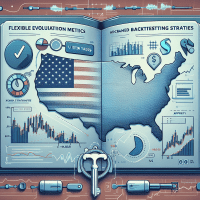Apex Trader vs E8 Markets: US Access & Multi-Platform Integration
In the competitive world of prop trading, having the right platform can be the difference between success and stagnation. This comprehensive guide compares two leading platforms – Apex Trader and E8 Markets – with a focus on US trading access and multi-platform tech integration. Whether you are a junior trader, a quantitative analyst, or a senior risk manager, our in-depth analysis will provide advanced strategies and insights to enhance your trading performance.
Understanding Prop Trading and Advanced Backtesting
Prop trading firms are highly selective environments where risk management and precise execution are paramount. Advanced backtesting not only confirms a trading strategy’s viability but also guides quantitative adjustments by simulating real-world market conditions. In our detailed analysis, we explore essential backtesting concepts including walk-forward optimization, out-of-sample testing, and automated parameter tuning.
Key Backtesting Concepts for Prop Trading
- Common Pitfalls: Overfitting, survivorship bias, and look-ahead bias can mislead traders. Expert techniques such as cross-validation and robust statistical testing help mitigate these risks.
- Walk-Forward Analysis: Unlike traditional backtesting, walk-forward testing adjusts strategies iteratively, making them resilient against market shifts.
- Integration with Forward Testing: Combining backtesting with paper trading ensures that strategies remain effective under live market conditions.
- Data Quality: Emphasizing accurate tick and bar data, handling missing entries, and adjusting for corporate actions improves simulation fidelity.
In-Depth Tool Comparison for Prop Trading and Backtesting
This section offers a detailed comparison of commonly used automated backtesting and prop trading tools, emphasizing real-world functionality, data depth, integration capabilities, and pricing structures.
| Tool | Backtesting Features | Data Quality & Coverage | Integration Capabilities | Pricing & Use Cases |
|---|---|---|---|---|
| TradingView | Event-driven, vectorized backtesting, automated alerts | Extensive historical data, multiple asset classes | API access, broker integration, charting widgets | Free tier available; scaled for both retail and prop firms |
| MetaTrader 5 | MQL5 automated scripts, stress testing, parameter optimization | Quality historical data, forex and CFD support | Broker integration, custom indicators, extensive plugins | Free with brokers; ideal for both individual and team trading |
| NinjaTrader | Robust simulation, commission/slippage modeling, automated strategy testing | Deep market data, futures, forex, equities | API integration, add-ons for enhanced analytics | Paid platform; suited for institutional prop firms and serious retail traders |
Each tool offers unique strengths. For example, TradingView excels in user-friendly charting and community scripts, whereas NinjaTrader provides a more granular backtesting environment essential for institutional risk management. Prop firms benefit from robust integration and team collaboration features found in platforms like MetaTrader 5 and NinjaTrader.
Advanced Backtesting Techniques: From Theory to Practice
Implementing advanced backtesting strategies in a prop trading environment requires a disciplined methodology. Here are some advanced techniques:
1. Mitigating Overfitting and Biases
Traders often fall into the trap of overfitting their algorithms to historical data. Maintaining a strict out-of-sample test set is crucial. Use statistical measures such as the Sharpe ratio, maximum drawdown, and profit factor to evaluate strategy performance objectively.
2. Walk-Forward Optimization vs. Traditional Backtesting
Walk-forward analysis continuously updates model parameters with each iteration. This method permits iterative refinement, ensuring that strategies adapt to emerging market conditions. In contrast, traditional backtesting uses a fixed dataset, potentially overlooking market evolutions.
# Example Python code for Backtrader strategy
import backtrader as bt
class SimpleStrategy(bt.Strategy):
def __init__(self):
self.sma = bt.indicators.SimpleMovingAverage(self.data.close, period=15)
def next(self):
if self.data.close[0] > self.sma[0] and not self.position:
self.buy()
elif self.data.close[0] < self.sma[0] and self.position:
self.sell()
cerebro = bt.Cerebro()
# Setup data, broker, and strategy here
cerebro.run()
3. Integrating Forward Testing
Once backtesting signals a viable strategy, forward testing (paper trading) is the next essential step. This stage uncovers real-world execution challenges, and it is strongly recommended to monitor key metrics such as slippage and latency.
Case Studies: How Prop Firms Leverage Backtesting Tools
Several prop trading firms have successfully implemented advanced backtesting techniques to refine their trading strategies. In one case study, a mid-sized prop firm integrated MetaTrader 5 for its robust simulation capabilities and NinjaTrader for detailed commission modeling. The firm enhanced its Sharpe ratio by 20% and reduced maximum drawdown by 15% during market turbulence.
An anonymized case study revealed these key steps:
- In-depth parameter optimization using walk-forward techniques.
- Rigorous testing for overfitting with a defined out-of-sample dataset.
- Automated report generation which expedited decision-making by 25%.
These examples demonstrate how detailed backtesting and continuous strategy adjustments play pivotal roles in the success of prop trading operations.
Regulatory and Compliance Insights
Prop trading operations in the US require keen awareness of regulatory norms such as NFA rules, while European firms must align with MiFID II and ESMA regulations. The choice of trading platform can also influence compliance, as certain platforms offer built-in compliance checks and audit trails. Prop firms should always review the regulatory frameworks applicable to their operating regions and incorporate these considerations into their backtesting and live deployment processes.
Expert Guidance and Next Steps
For professional prop traders and risk managers, the integration of advanced backtesting methods is not optional—it’s a critical success factor. We recommend the following actionable steps:
- Review your current backtesting methodologies: Are you leveraging walk-forward analysis and out-of-sample testing?
- Benchmark your tools: Compare platforms such as TradingView, MetaTrader 5, and NinjaTrader.
- Follow our in-depth prop trading strategies guide to discover tailored approaches for risk management and optimization.
- Download our comprehensive Risk Management Checklist which outlines key parameters and metrics critical for enhancing strategy performance.
As of October 2023, staying ahead in prop trading demands continuous learning and adaptation. Engage with our additional resources, including upcoming webinars and detailed case studies, to stay informed and fine-tune your trading practices.
Conclusion
This comprehensive look at Apex Trader vs E8 Markets, combined with advanced backtesting insights, equips you with the tools needed to elevate prop trading strategies. By choosing the right platform and integrating rigorous data analysis, you are better positioned to navigate the competitive landscape. For more detailed checklists, algorithm examples, and strategic insights, subscribe to our newsletter and join our expert community.







